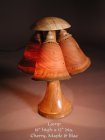I wish to turn small lamp shades. One comercial turner concluded aspen was best because it is more translucent than most woods. My problem is that it is not indigenous to my area and it is difficult to acquire. Does anyone have a link that lists woods by the property of translucency? What alternative species work well allowing enough light to shine through? What kind of finish works best?
-
April 2025 Turning Challenge: Turn an Egg! (click here for details) -
Congratulations to Kelly Shaw winner of the March 2025 Turning Challenge (click here for details) -
Congratulations to Ellen Starr for "Lotus Temple" being selected as Turning of the Week for 21 April, 2025 (click here for details) -
Welcome new registering member. Your username must be your real First and Last name (for example: John Doe). "Screen names" and "handles" are not allowed and your registration will be deleted if you don't use your real name. Also, do not use all caps nor all lower case.
You are using an out of date browser. It may not display this or other websites correctly.
You should upgrade or use an alternative browser.
You should upgrade or use an alternative browser.
Lamp Shade Wood Species
- Thread starter Dennis Weiner
- Start date
I believe aspen has interlocking grain....allowing it to be turned very thin.......seems to me it also has issues with mold, so turn it quick
I have not done one but one of our club members has done cherry and cedar. The cedar will crack rather easily. Another wood that turns thin well is box elder.
I have seen Norfolk Island Pine turned thin like this. I believe it is also soaked extensively in oil but I have never tried this. Hopefully someone will come by with more info.
Doug
Doug
Holly is very translucent I believe. I have turned white ash thin enough to see through (not on purpose mind you!) Bass is hard to turn because it's so soft but also very bright
- Joined
- Jan 27, 2005
- Messages
- 13,090
- Likes
- 5,547
- Location
- Dalworthington Gardens, TX
- Website
- pbase.com
I have seen Norfolk Island Pine turned thin like this. I believe it is also soaked extensively in oil but I have never tried this. Hopefully someone will come by with more info.
Doug
I agree with Douglas. NIP is the only species that I have seen used for lampshades and, as he said, it has to be soaked in oil to help it remain translucent. Most wood is translucent while still wet, but become opaque as soon as they dry. My presumption is that it needs to be a wood that has very oily heartwood. I know of several species of pine that meet that requirement, but getting one large enough to have sufficient heartwood is the challenge. The heartwood of Ponderosa pine an especially oily species, but I don't know if it would be good for making lampshades. Here is a link to some pine lampshades: http://www.jacksonwoodworks.com/lamps-with-shades.html
- Joined
- Apr 27, 2004
- Messages
- 9,155
- Likes
- 5,759
- Location
- Lakeland, Florida
- Website
- www.hockenberywoodturning.com
Any light wood is likely to work.
The trick is turning it thin.
My suggestion is to google "Andre Martel" " lamp shade"
Andre is a superb end grain turner.
Here is note on Andre Martel from the Carolina mountain woodturners
http://s3.amazonaws.com/cmwt.production/paperclip/files/397/cmw200411.pdf?1330567733
The trick is turning it thin.
My suggestion is to google "Andre Martel" " lamp shade"
Andre is a superb end grain turner.
Here is note on Andre Martel from the Carolina mountain woodturners
http://s3.amazonaws.com/cmwt.production/paperclip/files/397/cmw200411.pdf?1330567733
- Joined
- Apr 27, 2004
- Messages
- 9,155
- Likes
- 5,759
- Location
- Lakeland, Florida
- Website
- www.hockenberywoodturning.com
Any light wood is likely to work. The trick is turning it thin.
My suggestion is to google "Andre Martel" " lamp shade"
Andre is a superb end grain turner.
Here is note on Andre Martel from the Carolina mountain woodturners
http://s3.amazonaws.com/cmwt.production/paperclip/files/397/cmw200411.pdf?1330567733
Most light woods are quite translucent when wet at 1/4" and sometimes at 3/8".
It is sort of a fiber optic effect with the water transmitting the light.
When dry most woods they need be under an 1/8" thick to keep any translucency.
NIP is a wood that when saturated with oils will transmit the light through the oil when dry with walls 3/16 to maybe a 1/4" thick.
Also depending on style shades do not need to be translucent. A friend of ours has a nice wall mounted lamp that has a cherry shade.
Basically a NIP shade could be thicker than a poplar shade.
Al
My suggestion is to google "Andre Martel" " lamp shade"
Andre is a superb end grain turner.
Here is note on Andre Martel from the Carolina mountain woodturners
http://s3.amazonaws.com/cmwt.production/paperclip/files/397/cmw200411.pdf?1330567733
Most light woods are quite translucent when wet at 1/4" and sometimes at 3/8".
It is sort of a fiber optic effect with the water transmitting the light.
When dry most woods they need be under an 1/8" thick to keep any translucency.
NIP is a wood that when saturated with oils will transmit the light through the oil when dry with walls 3/16 to maybe a 1/4" thick.
Also depending on style shades do not need to be translucent. A friend of ours has a nice wall mounted lamp that has a cherry shade.
Basically a NIP shade could be thicker than a poplar shade.
Al
Last edited:
I agree with Douglas. NIP is the only species that I have seen used for lampshades and, as he said, it has to be soaked in oil to help it remain translucent. Most wood is translucent while still wet, but become opaque as soon as they dry. My presumption is that it needs to be a wood that has very oily heartwood. I know of several species of pine that meet that requirement, but getting one large enough to have sufficient heartwood is the challenge. The heartwood of Ponderosa pine an especially oily species, but I don't know if it would be good for making lampshades. Here is a link to some pine lampshades: http://www.jacksonwoodworks.com/lamps-with-shades.html
Thanks Bill for that link. Beautiful stuff and thank you to everyone for your suggestions. Ash, Holly and NIF are on my list. Andre is terrific! I saw his demos many times. I never did ask him what wood he prefers when making lampshades. . Good idea to ask. Thanks again everybody.
I have turned numerous thin walled norfolk island pine lampshades and will do a demo making LED night lights at Space Coast Woodturners Club Melbourne FL Wed. 10/10/2018.

One lampshade in use is thin enough to be very flexible. It moves 1/4" in when poked lightly with my finger. It might move more but I do not want to crack it. I am fortunate to live where homes have100's of them growing and some are felled frequebtly.

One lampshade in use is thin enough to be very flexible. It moves 1/4" in when poked lightly with my finger. It might move more but I do not want to crack it. I am fortunate to live where homes have100's of them growing and some are felled frequebtly.
For something totally different, consider alabaster. coloradoalabaster.com
(I have no financial interest and have not yet tried it myself) Photo by Max Krimmel.

(I have no financial interest and have not yet tried it myself) Photo by Max Krimmel.

Cook pine and NIP are so close to each other that most people can't tell them apart. Those are 2 good choices. I have seen some nice lampshades turned from them...
Dennis, I just spoke with Dan Stephenson who had an article in last months AAA W magazine about Norfolk Island Pine. He says that to make wood translucent he uses a dunking bath of three parts of mineral spirits to one part boiled linseed oil. He does five soakings in a small tub with weights to hold the lampshade under the solution overnight. He repeats this for about five days until the green is filled with a solution which makes it very translucent and very brittle. I hope this helps, PatrickI wish to turn small lamp shades. One comercial turner concluded aspen was best because it is more translucent than most woods. My problem is that it is not indigenous to my area and it is difficult to acquire. Does anyone have a link that lists woods by the property of translucency? What alternative species work well allowing enough light to shine through? What kind of finish works best?
If there grows Poplar in the area you could try turning some, with an oil finish it should be translucent, I turned some Popple as they call it here, natural hybridized Poplar species.
The piece I had was not all nicely light wood, but still looks pretty good IMO, it also made it pose to make a picture in dark surrounding, as the light wood made it too bright for my picture taking.
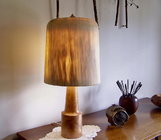
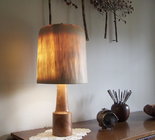
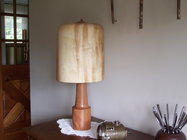
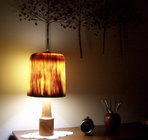
The piece I had was not all nicely light wood, but still looks pretty good IMO, it also made it pose to make a picture in dark surrounding, as the light wood made it too bright for my picture taking.




Hackberry and river birch both work. There was a recent post on this.
Well, if I wanted some thing decorative rather than a reading lamp, I think I would go with some burl with lots of holes in it, or maybe ambrosia maple. You could leave it a bit thicker and the holes would make for nice patterns on the walls. I would want one without a top on it as they need to vent the heat from the lights. I don't know how warm or hot the LEDs get, but I would still want some ventilation.
robo hippy
robo hippy

